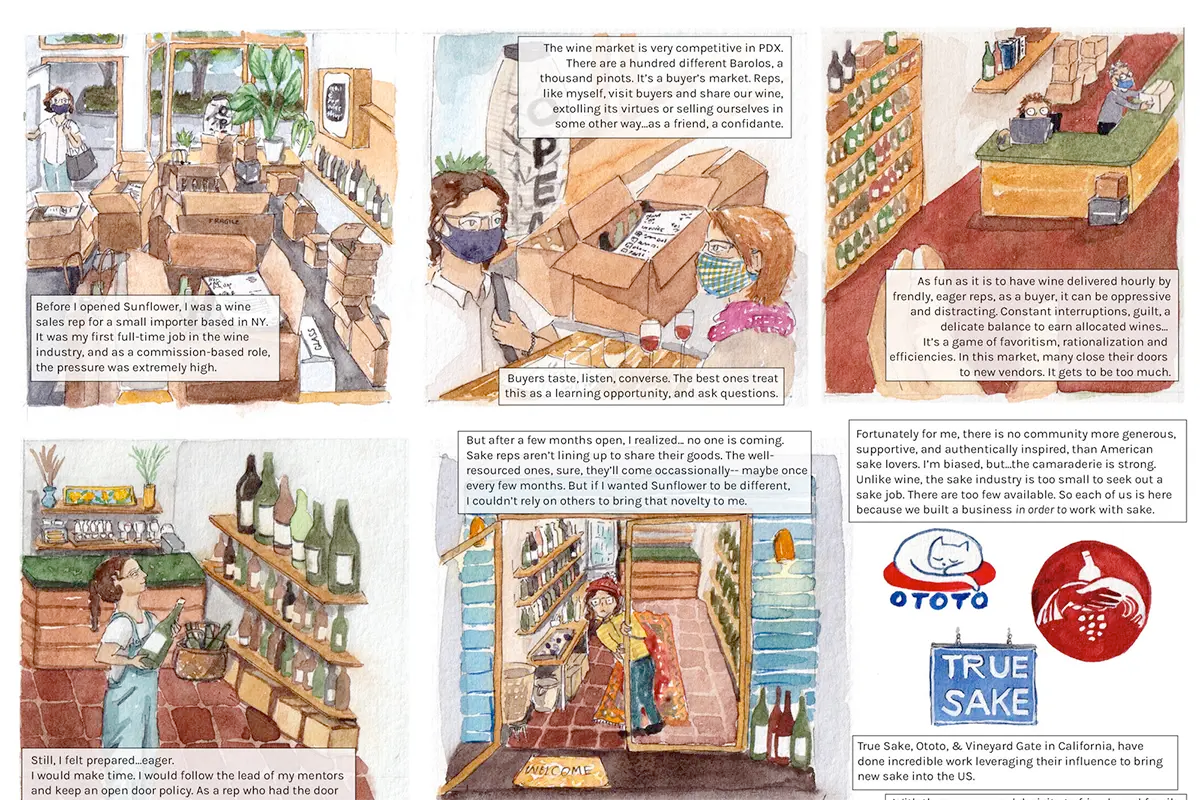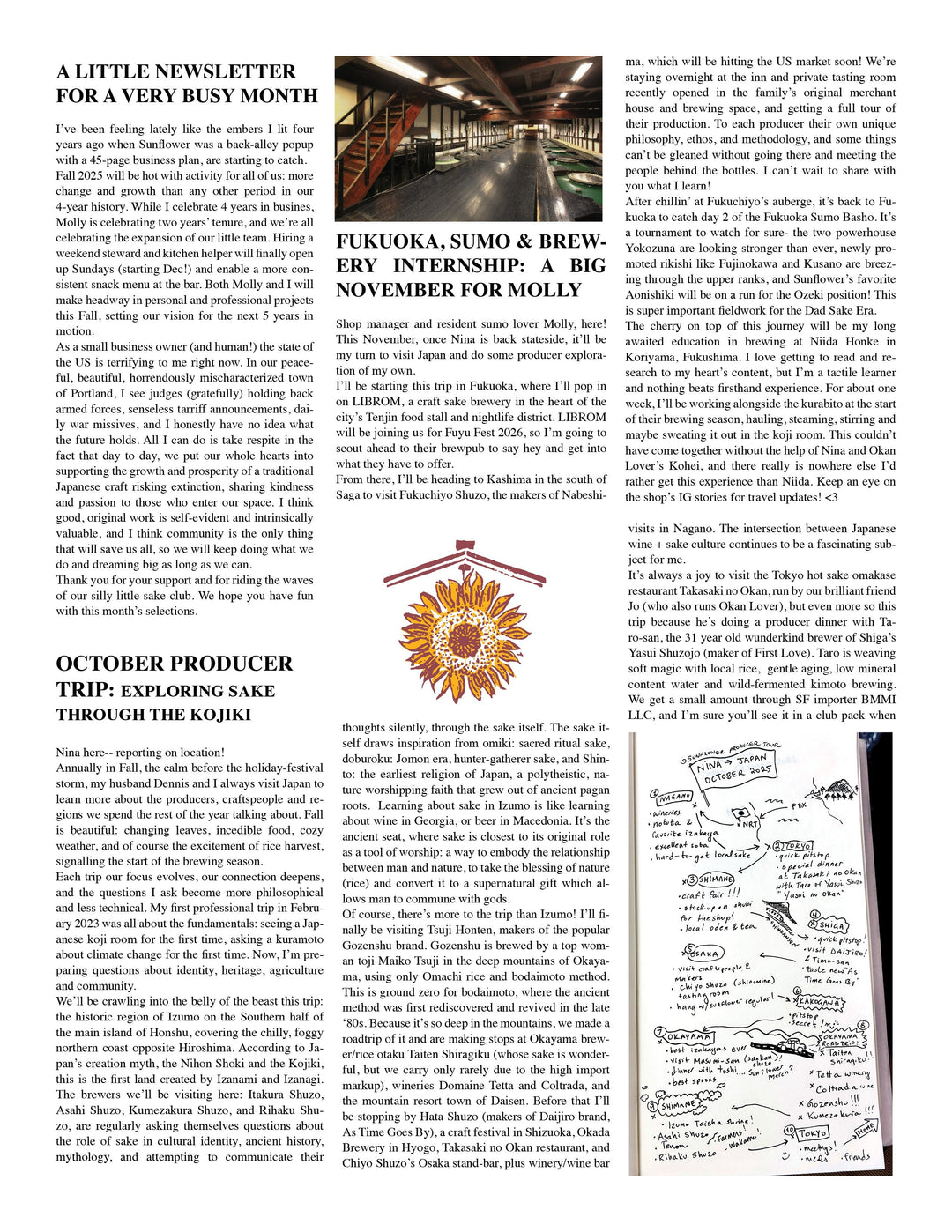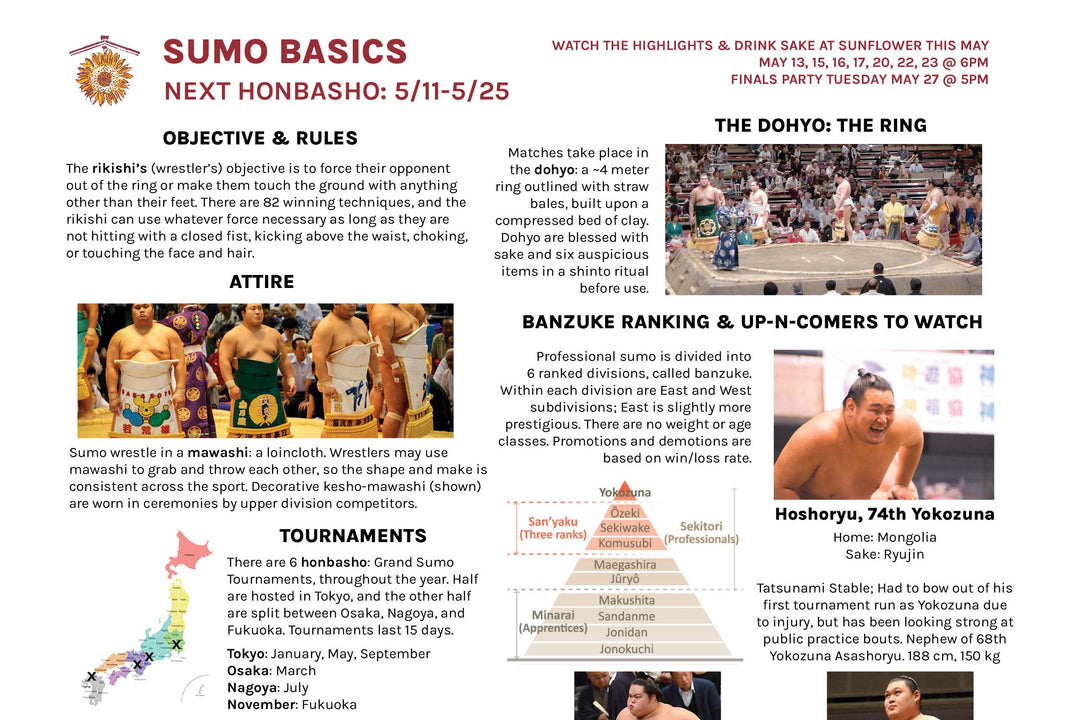JULY 23: The US Import Pathway: How Sake Gets from Japan to You

Sourcing sake is a complicated process. Alcohol is highly regulated, and the path from brewery to customer is complex: in all but one state, intermediary importers are required. I can't import even if I wanted to! Tariffs, fees, label review, countless hands to pass through. In July 2023, we used a comic to illustrate this process and its importance.


Sunflower Sake Club: July 2023
Background on Matsunoi Tokubetsu Junmai & Senkin Modern Kame no O
Sunflower’s July club needs a little side explanation, because the comic I made (while awesome and informative!) doesn’t address both club selections directly. So you’re probably left wondering, what are these sake exactly?
First: these are great bottles to enjoy in Summer. As much as I love rich, aged, mushroomy yamahai sake, I’m not generally going to share these styles in Summer (although, they are absolutely phenomenal with grilled meat and mushrooms). So both of July’s styles are delicious chilled, lightly chilled or room temperature. If you’re feeling up to it, the Matsunoi Tokubetsu Junmai can be warmed to around 110 for a more umami-rich effect.
Second, these bottles have something in common: this is the first time they’ve ever been to Oregon, and they are Sunflower exclusives. In fact, in the entire US, Matsunoi Tokubetsu Junmai can only be found at Sunflower!

After my visit to Matsunoi in Niigata last February, I was so taken by the place, its sake, and its toji, that I had to bring in more variety. Matsunoi’s Tokubetsu Honjozo “Lone Pine” is one of my best sellers and while the Tokubetsu Junmai is very different in style, it shares the same clean, fresh flavor and silky mouthfeel of the honjozo. So I started coordinating with the importer in March, and when the sake was bottled in April, the importer arranged to bring in a few cases for us: having the label approved by the FDA, coordinating chilled transport from Niigata all the way to Portland, and so on. It’s a very involved process, but the effort is so worthwhile, and your support is integral.
Personally, I find the Matsunoi Tokubetsu Junmai to be (in classic Niigata style) subtle, refreshing, and clean, but with a unique tropical quality: notes of pineapple, passion fruit, and fuji apple. It’s not ostentatious, it’s not screaming at you...but it has just enough personality to be enjoyable as a glass on its own. And it’s extremely flexible and complimentary with food. Two weeks ago I was serving it with dressed tofu and it found a way to compliment each different topping. With kimchi and kewpie mayo, the richness of the mayo was enhanced and I felt like the chile in the kimchi had more nuance. With green onion, ginger and soy sauce, the sake had so much more umami and less fruit. I’m excited to keep experimenting.
Matsunoi is brewed with Takane Nishiki polished to 55%, which is what qualifies the sake as tokubetsu: special. Takane Nishiki was bred in 1939, and while it dropped out of favor for a very long time due to difficulty farming, small amounts are grown in Nagano and Niigata for brewers in the know (about 440 metric tons total per year). Takane Nishiki also traces its parentage back to Kame no O, an heirloom variety that is used in the second July club selection.
Which makes for a good segue to Senkin Modern Kame no O, the second club selection for July! You may recognize this label from the April club pack, which included a 300ml of Senkin Modern Yamadanishiki. The difference, of course, is in the rice: Kame no O is brewed with 100% organically farmed local Kame no O, and Yamadanishiki is brewed with Yamadanishiki. It is made in a “modern” style which implies freshness, higher acidity– a style that pairs well with global cuisine and is enjoyable on its own, without food. Still, the lightly bitter finish and crisp character make Senkin fantastic with vinegared dishes. At the end of this letter, I’m sharing a recipe for Tosa marinated tomatoes which was super simple, and A++ as a pairing.
Senkin is an extremely ambitious brewery, given that they only use rice farmed within 5km and are totally committed to making their junmai daiginjo lines affordable. But the fact that they can manage this with Kame no O is really stunning. Kame no O is unique: it’s an heirloom rice that was first named and identified in the late 1800s in Yamagata prefecture. “Kame no O” translates to “turtle’s tail,” referring to a frond of hair that emerges from the growing rice grains. It’s a real pain to farm as it must be harvested entirely by hand, and without added fertilizer: fertilizer causes the stalks to grow too tall. This has kept overall production levels extremely low. Anytime you run into a sake brewed with Kame no O, know that there isn’t a whole lot of it out there. And as a cold-hardy heirloom variety native to Tohoku, which has given rise to countless other rice varieties (including Takane Nishiki!) I'm especially proud to finally have an example in the shop. And a lovely one, at that.
Tomatoes Marinated in Tosa Vinegar 

Recipe: Chef Kobayashi, Shuko Takigiya Izakaya, Shinjuku / Cookbook: Tokyo Izakaya (Tuttle)
Note: while I’m including the special dashi recipe, we prepared this dish with a high quality powdered dashi and it came out great.




